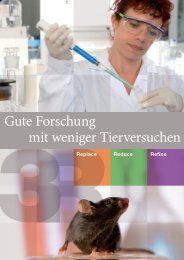Create successful ePaper yourself
Turn your PDF publications into a flip-book with our unique Google optimized e-Paper software.
are developing IVIVE models for specific<br />
compounds, such as phthalates, parabens,<br />
carbaryl and arsenic (Choi et al., 2011).<br />
Training<br />
Hamner staff from our Center for Human<br />
Health Assessment (CHHA), led by Dr.<br />
Harvey Clewell, held week-long courses,<br />
one in 2010 and the second in 2011,<br />
that included lectures on using PBPK<br />
modelling to conduct IVIV extrapolation for<br />
cell-based toxicity testing (thehamner.org/<br />
about-the-hamner/education-training/pbpkmodeling/#2011).<br />
The course material<br />
is available on the website. The Hamner<br />
group also led a continuing education<br />
course (CEC) on IVIVE at the 2011 SOT<br />
meeting. A Hamner-led proposal for a<br />
CEC on early life dosimetry and vulnerable<br />
populations has been accepted for the<br />
2012 SOT meeting.<br />
Conclusions<br />
Progress in developing case studies<br />
requires careful selection of prototype<br />
compounds and prototype pathways. In<br />
addition, contributions are necessary<br />
from a trans-disciplinary staff with<br />
diverse skills—assay design, genomics/<br />
bioinformatics, computational modelling,<br />
pharmacokinetics and human health risk<br />
assessment. Our programmes are moving<br />
forward with resources that are targeted<br />
to specific technical areas and slowly<br />
expanding to develop several case studies<br />
that span all the key technical areas<br />
required for success with any individual<br />
pathway assay. We are furthest along with<br />
case studies for the p53-DNA damage and<br />
the PPAR-a pathways. Work with these<br />
prototypes provides activities covering<br />
each aspect of risk assessment based on<br />
in vitro test results (Figure 1).<br />
The case study approach offers several<br />
advantages. First, it does not worry<br />
excessively over all challenges required to<br />
make a wholesale change in toxicity testing,<br />
focusing instead on the process by which<br />
in vitro toxicity information will/could be<br />
used for setting regulatory standards in<br />
specific instances. Second, it proposes<br />
learning by doing. Many key issues in use<br />
of the information will become apparent<br />
by moving ahead with the process. We<br />
can look tour own history and suggest<br />
that only a couple of successes with case<br />
studies will make the entire process go<br />
along much more easily. The two authors<br />
of this report were among a small group<br />
who brought PBPK modelling forward for<br />
use in risk assessment in the 1980s. It is<br />
an area that now has contributed widely to<br />
human health risk assessment. Based on<br />
our experience, the majority of challenges<br />
required to implement PBPK modelling to<br />
a diverse set of compounds were clearly<br />
defined with the application to the first<br />
two compounds—styrene and methylene<br />
chloride (Ramsey & Andersen, 1984;<br />
Andersen et al., 1987). History is likely to<br />
repeat itself with toxicity testing in the 21 st<br />
century. After completing the first two or<br />
three pathway case studies, most of the<br />
issues will become clear and expansion<br />
of the testing to other pathways will be<br />
greatly accelerated.<br />
AXLR8-2 WORKSHOP REPORT<br />
Progress Report 2011 & AXLR8-2 Workshop Report<br />
319




